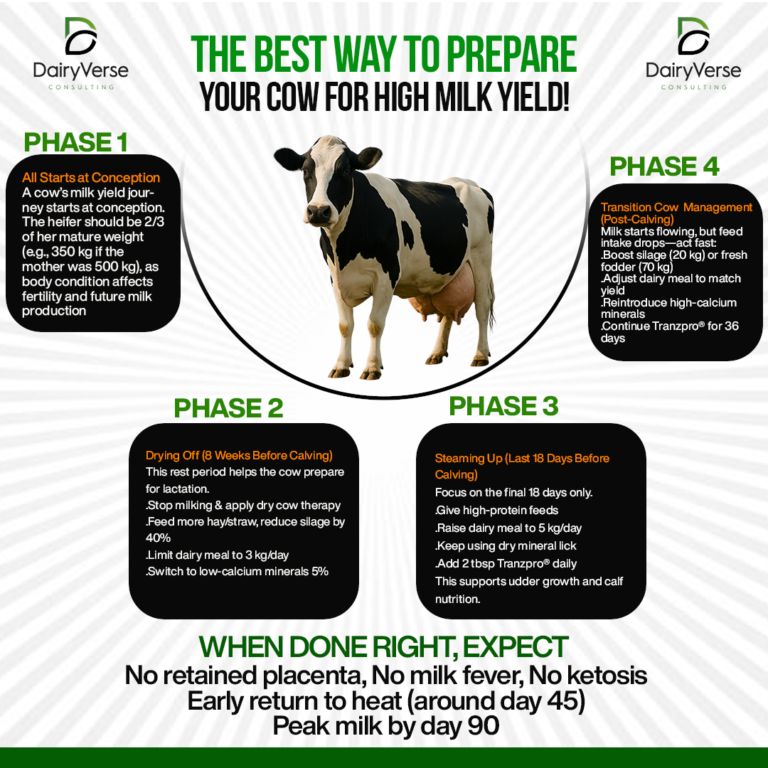Understanding the Cause of Watery Milk in Dairy Cows
Milk quality is a crucial indicator of a cow’s health, and issues like watery milk or low-fat content can signal underlying problems. In this article, we’ll explore a specific case where a cow produces watery milk with little to no butterfat. While treatment temporarily improves the situation, the problem reoccurs after about 20 days. Let’s dive into what might be happening and how to address it.
The Problem
The affected cow is exhibiting the following symptoms:
- Producing low-fat, watery milk with no taste or richness.
- When the milk is left to ferment (to create ‘maziwa lala’ or soured milk), it turns almost entirely to water, with minimal traces of milk solids.
- Treatment with dewormers and injections like Trypamed temporarily improves the milk quality, but the issue returns after a few days or weeks.
These symptoms suggest a combination of nutritional, health, and management challenges.
Possible Causes
- Poor Nutrition
- A cow’s diet plays a major role in milk production. A diet lacking in energy, protein, or essential nutrients results in poor milk quality. If the cow isn’t getting sufficient concentrates, roughage, or minerals, the milk may appear thin and watery.
- Solution: Ensure the cow is fed a balanced diet, including quality roughage (like hay or silage) and supplements if needed.
- Mastitis (Udder Infection)
- Mastitis is a common issue that affects milk composition. Even when it isn’t obvious (subclinical mastitis), it can cause the milk to lose its fat content, making it watery.
- Solution: Conduct a California Mastitis Test (CMT) or consult a veterinarian for a diagnosis. Maintaining udder hygiene before and after milking can prevent this condition.
- Parasitic Infestation
- Internal parasites, such as worms, can weaken a cow’s immune system, reduce feed efficiency, and impact milk production. Deworming temporarily helps, but if the cow is reinfected, the problem can quickly return.
- Solution: Administer a proper deworming schedule using effective medications. Ensure the environment is clean to reduce reinfection risks.
- Trypanosomiasis (Nagana)
- Trypanosomiasis, also known as nagana, is a disease caused by tsetse flies. Symptoms include low milk production, weight loss, and lethargy. The temporary improvement after Trypamed treatment suggests that the disease could be recurring due to reinfection or incomplete treatment.
- Solution: Control tsetse flies in the area using traps or sprays. Ensure the cow receives the full treatment course as prescribed by a veterinarian.
- Stress and Poor Management
- Stressful conditions, such as overcrowding, lack of rest, or poor housing, can also reduce milk quality. If the cow is not comfortable, her body won’t prioritize producing quality milk.
- Solution: Provide a clean, comfortable, and stress-free environment for the cow.
How to Fix the Problem
To address these recurring issues, consider the following steps:
- Consult a Veterinarian
- A veterinarian can conduct tests for mastitis, trypanosomiasis, and other infections to identify the root cause.
- Improve Nutrition
- Proper nutrition is crucial for improving milk quality and overall cow health. A balanced diet should include quality roughage, concentrates, and essential minerals.
- Use Booster+®: This supplement significantly improves metabolic processes in dairy cows, promoting overall health and productivity.
- High Protein and Energy Content: Booster+® is rich in protein and energy, which are essential for milk yield and the cow’s overall well-being.
- Benefits:
- Increased Milk Yield: Booster+® supports cows in achieving higher milk production, particularly those that have been lagging in yield.
- Recovery Support: It helps previously ill cows recover swiftly and return to optimal production levels.
- Heat Onset Enhancement: Booster+® reduces delays in heat onset for milking cows.
- Body Condition Improvement: It improves body condition, combats stunted growth, and ensures the cow maintains a healthy weight.
- Maintain Hygiene
- Clean the cow’s udder before and after milking. Keep the living area dry and clean to reduce the risk of infections and parasites.
- Follow a Proper Deworming Schedule
- Use effective dewormers at regular intervals. Monitor the cow’s fecal matter for signs of reinfection.
- Control Tsetse Flies
- If trypanosomiasis is confirmed, implement measures to reduce tsetse flies, such as insecticides, traps, or clearing bushes where the flies breed.
- Monitor Milk Quality
- Regularly check the cow’s milk for signs of improvement or recurring issues. Track how long the improvements last after treatment to help your vet identify patterns.
Conclusion
Watery milk in dairy cows can stem from a range of issues, including poor nutrition, infections like mastitis, parasites, and trypanosomiasis. While temporary treatments provide short-term relief, addressing the root cause is essential for long-term improvement.
By incorporating a high-quality supplement like Booster+®, improving the cow’s diet, ensuring proper hygiene, and seeking veterinary support, you can restore milk quality and productivity. Healthy cows mean better milk production—and a happier farmer!
If you’re facing similar challenges, don’t hesitate to consult a veterinarian for personalized advice. Remember, prevention is always better than cure!







